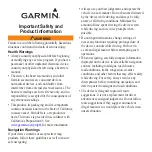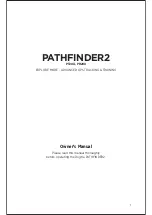
Flight Management System (FMS) for the Agusta AW139/AB139 Helicopter
A28--1146--181
REV 3 Mar 2009
7-29
Flight Plan
Honeywell International Inc. Do not copy without express permission of Honeywell.
During path descents, AT OR ABOVE or AT OR BELOW
constraints are
not
treated as AT constraints. FMS can look
further in the flight plan to determine when other constraints
exist. FMS can fly a single path meeting all constraints rather
than multiple paths that treats each constraint as an AT
constraint.
After passing the last waypoint with an altitude constraint, FMS
changes from path descent (VPATH) to a speed descent
(VFLCH) mode.
VNAV Special Operations
D
Vertical DIRECT--TO
-- This function operates much like the lateral
DIRECT--TO.
D
VNAV and Holding or Orbit Patterns
-- There are some special
considerations for holding and orbits during VNAV operation.
—
When the holding or orbit pattern is entered while in VALT, the
aircraft remains in VALT.
D
VNAV (VPATH and VFLCH) and Stored Instrument Approaches
—
All stored approach procedures have altitude constraints and/or
associated vertical path angles.
—
Changing the altitude constraint and/or path descent angle once
an approach procedure has been activated is permitted. The
crew must verify all the approach procedure altitude
requirements are met.
—
Industry wide standards for database information are currently
inconsistent on many approaches. Some vertical paths are
defined to 50 ft above the runway. Others do not arrive at MDA
until at the MAP. Some approaches give vertical guidance below
the published MDA and some vertical paths differ from the
VASI/PAPI angles.
—
The stored missed approach also contains altitude constraints.
Some altitude constraints do not refer to any waypoint. The FMS
is able to fly the missed approach to comply with missed
approach altitude constraints. During the missed approach, the
speed command is the PERFORMANCE INIT missed approach
speed until the destination waypoint is changed or a flight plan
is changed.
Summary of Contents for FMZ Series
Page 3: ......














































